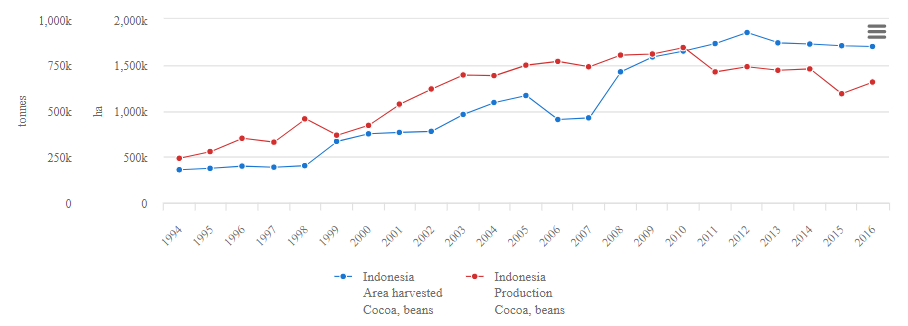The world’s forests play key roles in carbon sequestration and habitat protection, as well as providing important social and economic functions. Agriculture and large-scale production is the most significant driver of global deforestation and commodities such as oil-palm are produced on large scale estates, often established on deforested land in the tropics (MacDicken, 2015).
Globally, Indonesia has one of the largest proportions of forested areas as of 2015, representing 53% of the country’s land area, and is a significant store of carbon (H. Gibbs, Brown, O Niles, & A Foley, 2007; Saatchi et al., 2011). In 2014-2015 Indonesia was the largest emitter of carbon dioxide from deforestation, emitting almost 1 million GtCO2eq, three times more than that of Brazil which was the second highest. Between the period 1990 and 2015, it is estimated that deforestation in Indonesia has resulted in about 8GtCO2 being released into the atmosphere (FAO, 2018).
Indonesia is now the third largest producer and exporter of cocoa beans after Côte d’Ivoire and Ghana (FAO, 2018). The cocoa industry currently has an important economic role as well as providing employment and livelihoods for millions of smallholder families (Akbar, 2015). The importance of these forests as well as the economic importance of cocoa production is reflected in the many studies on the climate friendliness of current cocoa production models (Schroth, Jeusset, et al., 2016; van Rikxoort, Schroth, Laderach, & Rodríguez-Sánchez, 2014).

Cocoa bean production and area harvested in Indonesia 1994-2015 (FAO, 2018)
Unlike annual crops which are harvested every year, perennial tree crops have the potential to store carbon, especially when grown in traditional agroforestry systems (IPCC, 2006; Schroth et al., 2015). Cocoa was traditionally grown in the shade of rainforests, but recent years have seen large scale deforestation to make way for short term, intensive, full-sun cocoa plantations which produce higher yields in the short term but have long term sustainability issues related to loss of biodiversity, loss of food security and livelihood uncertainties (Belsky & Siebert, 2003).
There is a need to develop a methodology for measuring aboveground biomass and carbon stocks at a directly national level (H. Gibbs et al., 2007; Salunkhe, Khare, Kumari, & Khan, 2018) for a country such as Indonesia in order to be able to quantify the impact national cocoa production. Ongoing advances in remote sensing techniques allowing larger areas to be covered than before through verification from field data and data from other sources such as Geographical Information Systems (GIS).
